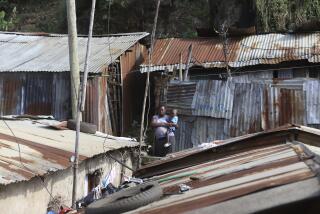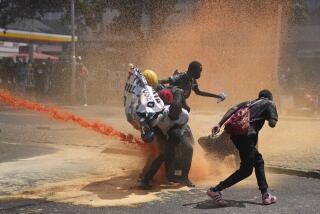Culture : Kenya’s Most Dangerous Game? Driving : Shabby highways, careless motorists and decrepit cars cause one death for every 71 vehicles on the road. The record imperils tourism.
- Share via
NAIROBI, Kenya — There is bougainvillea along the road. And there is bougainvillea in the road. Recognizing the difference in Kenya can mean your life, or at least your grillwork.
These are among the most dangerous and unforgiving roads in the world.
A towering bougainvillea along the shoulder might be a welcome distraction from the neurotic traffic that jounces over the streets day and night. But that colorful vine lying loose ahead could signify that a dump truck has overturned just around the hairpin corner.
Slam on your brakes, and cross your fingers in hope that the tailgater in the swayback pickup behind you has any brakes left at all.
These days, bougainvillea is all over the roads. Red flags are scarce and valuable enough to steal. So the brightly colored vines, used as Kenya-style traffic warnings, are strange symbols of the national decay that is cramping commerce, interfering with one of Africa’s premier tourist industries and costing lives.
Kenya is a proud, self-conscious country. So the ordinary hazards of African life--like political turmoil, poverty and disease--are often publicized cautiously here. Kenyans say the developed world should keep these problems in perspective. But when it comes to this country’s has-been roads, its wayward drivers and their sorry vehicles, even Kenya cannot help but cry out, if only for mercy.
Consider a sampling of recent headlines in Nairobi newspapers:
“Death at Dawn--34 Killed in Horror Smash” . . . “Carnage on Roads” . . . “107 Killed in Road Accidents in a Week” . . . “3 More Tourists Killed.”
In one week, both Kenya’s president and its attorney general attended funerals decrying the loss of prominent citizens killed on the country’s perilous roads.
In California, no stranger to traffic horrors, one highway fatality was recorded for every 6,289 registered vehicles in 1994. In Kenya, there was a death for every 71 vehicles on the road.
Per capita death rates are more than 10 times as high as in Europe, and they’re growing, says the Kenya Automobile Assn.
“In Nairobi, we pray before we drive. We get in our cars, and we hope we survive,” says Alfred Nganga Mutua, a college student. “The system of bad roads, bad cars and bad drivers has pushed people to the brink.”
You could argue that there is a positive side to Kenya’s potholed, washed out, decayed and chaotically overcrowded roads. Because the drivers are arguably worse than the roads--and the dilapidated condition of an average Kenyan vehicle worse still--better roads might only mean higher speeds and more efficient carnage.
“One key to surviving . . . is simply patience,” says Gavin Bennett in a guide offered by Kenya’s auto club. “Patience with the driver who stops in the middle of the road to talk to a friend or take on passengers, patience with the character who appears on the wrong side of the road, patience with the queue jumper whose car is covered with battle scars, patience with the policeman who stops you on the only road for 100 miles around and asks where you are going, patience with the donkey and the cart that slows you to crawling pace up a long hill, patience with the driver who indicated right and turned left.”
But patience will go only so far. The perilous roads are threatening progress itself on the continent.
In any given year, tourism vies with tea exports as Kenya’s No. 1 cash earner. Kenya is also a commercial hub for the continent, providing transportation links between Tanzania and Uganda. Perhaps half the goods shipped via the coastal ports of East Africa travel the roads of Kenya.
Over the Christmas holiday, the two-lane road from Nairobi to the port of Mombasa--the most important “highway” in this part of the world--simply gave out. Even Africa’s much-feared and fearless bus drivers said it was unsafe to traverse the giant potholes and crumbling shoulders that sent traffic careening from one lane to the other, frequently straight into oncoming traffic.
“All the buses arriving in Nairobi have broken springs and worn tires. The loss involved is colossal, and we cannot afford it,” said John Wainaina as he announced that his Arusha Bus Express was canceling 12 buses a day on the road.
In one week during the current peak tourist season, back-to-back crashes killed four German and three Italian tourists. Seven tourists were critically injured. Hundreds of people were stranded when their cars and buses were run into ditches, disabled by elephantine potholes or blockaded by wrecks along the way.
International tour organizers announced that they were scaling back their operations here because of treacherous roads. Kenyan officials responded with anger. Mohammed Jahazi, a local political party official in tourist-dependent Mombasa, reasoned that accidents happen on smooth highways too.
Nonetheless, the embarrassed Kenyan Public Works Ministry rushed to repair the Nairobi-to-Mombasa road--packing dirt into the potholes and shoring up shoulders. Within two weeks, travelers said the makeshift repairs were washing away from heavy use and weather.
Such slipshod maintenance is not surprising. Corruption in public service, a swelling population, the incivility that arises when poverty lives next to ostentatious wealth and an aging infrastructure make the task of keeping things up to snuff seem futile.
Traffic lights in Nairobi work intermittently. Sometimes, there is no electricity. Other times, the electricity is OK, but the bulbs have been stolen.
Outside the city center, Nairobi roads wander in crazy twists, rarely straight for more than a few yards at a time. Traffic moves at two speeds--breakneck and breaking down. That man in a compact sedan who lurches onto the sidewalk to dodge congestion may not be a daredevil. Perhaps he is only accommodating his lack of brakes.
Shoppers buy their cigarettes, magazines, flowers, curios, dustpans, barbecues, pineapples, even puppies from hawkers who dart through the moving traffic--and sometimes straight into it.
Young boys sit on stools in the middle of a street hammering at large rocks to break them into smaller ones to fill particularly cruel potholes. For this, they ask passing drivers for tips. Within a day or two, the stones are mostly gone, flung up by tires into windshields and grilles. And the boys are back with their hammers.
Perhaps the worst terror comes from the makeshift public transportation that tens of thousands of Kenyans rely on: the private minivans and minibuses known here as matatus .
Typically overstuffed three times beyond capacity, some matatus are painted shocking pink or bright blue. Others are just rusty hulks of pickups with shells over the bed.
They are operated, Wild West-style, by private entrepreneurs: The greatest rewards come to those who can propel the most passengers down the road the quickest with the least money diverted to trifles such as maintenance.
During rush hour, matatus can be seen with 36 adult passengers, a few head of livestock, uncounted children, a day’s worth of shopping bags and, often, a fare-payer riding on the driver’s lap--all in a 12-person van.
Loaded as they are, a matatu can easily go 60 m.p.h. downhill on a residential street but only 5 m.p.h. uphill. Still, a 6-m.p.h. matatu is honor-bound to attempt to pass its slower counterpart, no matter what the traffic or blind corners hold ahead.
Most will make it. The others you will find just beyond the fresh bougainvillea.
More to Read
Sign up for Essential California
The most important California stories and recommendations in your inbox every morning.
You may occasionally receive promotional content from the Los Angeles Times.













